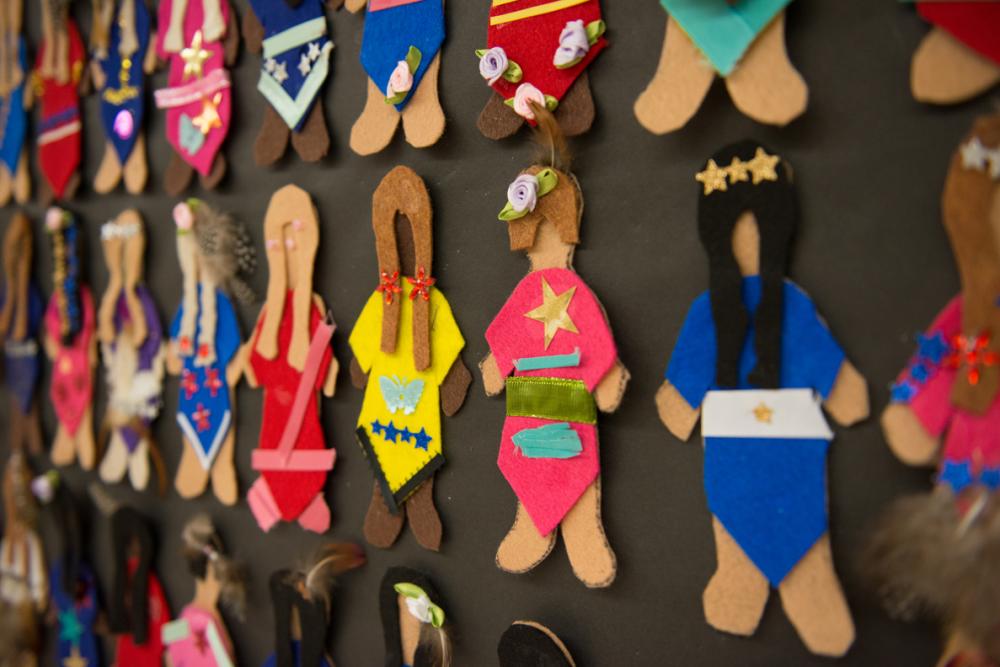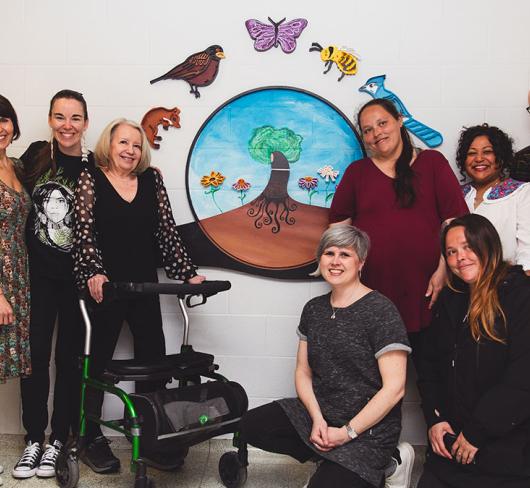
Faceless Doll Project: Commemorating Missing and Murdered Aboriginal Women and Girls
What is the Faceless Doll Project and how did you come across it?
In 2010, the Native Women’s Association of Canada (NWAC) released a report called What Their Stories Tell Us. The report resulted from five years of research by the Sisters in Spirit Initiative. It revealed as many as 582 known cases of Aboriginal women and girls who have gone missing or been murdered in Canada. NWAC wanted to create a visual representation of these women and girls so they would not be forgotten. The Faceless Doll Project came out of research conducted by the Ontario Native Women’s Association (ONWA).
I learned about the Faceless Doll Project when I stopped in at Lakehead University’s Aboriginal Awareness Centre to talk with Helen Pelletier. We got into a conversation about the number of known and unsolved cases of missing and murdered Aboriginal women and girls across Canada. When Helen mentioned the known number was as high as 582, I quickly volunteered to help her in her quest to make faceless dolls to commemorate all of the women and girls.
Why are the dolls faceless?
The Aboriginal women and girls who are missing or have been murdered are victims of crime, and therefore faceless. They are also faceless because they are devalued by society.The dolls are a visual representation of the girls and women who need to be remembered and they offer a way to find closure for their grieving families. In the known cases of missing and murdered women and girls, they are people’s sisters, mothers, aunts, grandmothers, and friends. Their unsolved cases leave a void in their families’ lives. These women and girls have also been forgotten by society. When I posed the question to a group of students, “Does anyone know why the dolls are faceless?” one grade 8 student said, “Society has stopped looking for them.”
Why did you and your colleagues get involved with this project?
For me, this project sheds light on the low value society places on our Aboriginal peoples in Canada, especially our women and girls. I got involved with the project because of the sheer number of Aboriginal women and girls who have been affected by violence. When Helen introduced me to the project, I felt compelled to help her. It was a way to honour the missing and murdered Aboriginal women and girls and their families.
My original intent was to have just my Native as a Second Language classes at École Gron Morgan and Algonquin Public School participate in the Faceless Doll Project. I then asked other colleagues if they would like to participate, and most classes quickly jumped on board. Before long, most of the teachers from each school who knew about the project wanted their classes to participate as well. The project grew to include most grade 2 to 8 classes at both schools. I am very proud to be supported by colleagues who understand the purpose of this project.
During presentations in the intermediate classes the project provided a way to talk about the intergenerational traumas of colonization, and to discuss the cycles of trauma and abuses that the residential school era, the 60s scoop, and government and church interferences had on First Nations peoples across Canada over the last 500 years. To quote NWAC: “To address the issue of violence, one must understand the history and impact of colonization on Aboriginal peoples in Canada. It is the ongoing narration of violence, systemic racism and discrimination, purposeful denial of culture, language, and traditions, and legislation designed to destroy identity that has led to the realities facing Aboriginal peoples. The overrepresentation of Aboriginal women in Canada as victims of violence must be understood in the context of a colonial strategy that sought to dehumanize Aboriginal women.” This project for me is about education on the history of our First Nations peoples and bringing positive change.
Why did you decide to introduce the project to students?
Raising awareness was the main motivator for introducing this project to students. In the Native Language curriculum, topics of cultural relevance are an important part of the program. It is important that our young people learn their own histories, and the history of our people in Canada before and after early European contact. My students learn the importance of our language and that our learning comes from a living language experience. The majority of Native Language learners in the schools where I teach are young women, and this project is a way to engage them in learning and empower them to promote change. When I was in school I did not learn my own history. I didn’t know my mother was a residential school survivor until later in life. My own children did not learn about their culture or language in elementary or secondary school. I want my students to learn and understand that we, as First Nations peoples, had healthy communities before contact.
During the presentation and making of the faceless dolls, my grade 8 Native as a Second Language students helped the students in the primary and junior classes. This was an empowering leadership experience for them. When we wrapped up each class, my intermediate students left feeling confident and said they enjoyed working with their partners.
How did students respond to the project and the history behind it?
Many students were uncomfortable initially when the project was presented. They wondered why the dolls were faceless. As we examined the situation using information from ONWA, they began to understand that the dolls were faceless because society ignores what has happened, or is apathetic, thereby creating a society that devalues Aboriginal peoples in Canada. After presenting the information about why we were doing the Faceless Doll Project, students were positive and worked meticulously with their design to complete their dolls.
Students could not believe that these things were happening and wondered why no one was looking for answers to the missing and murdered Aboriginal women and girls. When we look at pre-contact society, Aboriginal women were honoured because the Creator gave them the gift of giving life and they were valued in the community for this gift. As the students began to construct the dolls, boys and girls alike felt that they were valuing and giving a voice to the missing and murdered Aboriginal women and girls with their faceless dolls. They took great care with the design, indicating that the person they were honouring was important.
Can you talk about the process for making the dolls?
The templates for the dolls were from the ONWA website. I had my grade 8 students cut out the dolls, dresses, and hair for each student making a faceless doll. Helen provided materials to decorate the dolls and the felt that the dolls and dresses are made from. My grade 8s helped in each class with the distribution of materials and then worked with individual students to make their dolls. The grade 8s helped with guiding the students in choosing materials, gluing materials in the younger classes, and simply spending time with younger students in conversation. Once the faceless dolls were completed my intermediate students would collect all the faceless dolls and materials for the next class.
What kinds of curriculum connections were you able to make?
While speaking with Helen Pelletier and Charmaine Romaniuk from the Aboriginal Awareness program at Lakehead University about this project, I immediately felt that it was relevant to the curriculum topics that we were working on. As part of the grade 8 Native Language curriculum, we study various aspects of First Nations culture and also the history of First Nations peoples in Canada. This includes topics such as residential schools, the 60s scoop, and the overall intergenerational traumas that Native families experienced and whose effects are still felt today. Residential schools and the 60s scoop are both examples of Aboriginal children being removed from birth families and forced into non-Aboriginal environments. In the 1960s, thousands of children were taken from their families. Missing and murdered Aboriginal women and girls is one of the important and relevant topics that helps to explain past and current situations in Canada that affect First Nations peoples.
When we go into primary and junior classes, our focus is a bit different and importance is placed on family members and their roles. Mothers are important to us because they nourished us in the womb for nine months and while we were in the womb they fed and kept us safe. We make the connection between the beat of the drum and listening to our mothers’ heartbeat for nine months. Our sisters, aunts, and grandmothers are also very important to the family and we talk about those connections too.
What is going to happen to the dolls once they are made?
Once the faceless dolls are completed at both École Gron Morgan and Algonquin Public School, I will collect all the dolls and bring them to Lakehead University. Helen Pelletier and Charmaine Romaniuk from the Aboriginal Awareness Centre are planning to put the dolls on display and to hold a ceremony for all of the missing and murdered Aboriginal women and girls. This is more important than ever as a recent report released by the RCMP says the number of missing and murdered Aboriginal girls and women may be over 1000, almost doubling NWAC’s 2010 findings. The Native as a Second Language classes from both public schools have been invited to sing “O Canada” in Ojibwe to help honour the Aboriginal women and girls.
Both schools are pleased to be a part of Lakehead University’s ceremony in recognizing the Aboriginal women and girls who are missing or have been murdered in Canada.
Corine Bannon is a member of the Lakehead Teacher Local.

